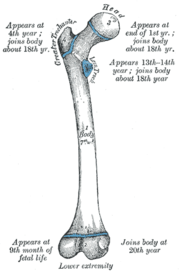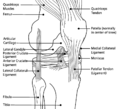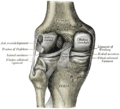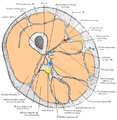عظم الفخذ
- للافقاريات، انظر ساق مفصليات الأرجل.
| العظمة: عظم الفخذ Femur | ||
|---|---|---|
| Anterior view of the femur | ||
| لاتينية | os femoris | |
| Gray's | subject #59 242 | |
| Origins | Gastrocnemius , Vastus lateralis, Vastus medialis, Vastus intermedius | |
| Insertions | tensor fasciae latae, gluteus medius, gluteus minimus, Gluteus maximus, Iliopsoas | |
| Articulations | hip: acetabulum of pelvis superiorly knee: with the tibia and patella inferiorly | |
| MeSH | Femur | |
عظمة الفخذ femur أو thigh bone هي أدنى (أقرب إلى الجسم) عظام الرجل في الفقاريات القادرة على المشي أو القفز، كما هو الحال في معظم الثدييات الأرضية والطيور والعديد من الزواحف مثل السحالي والبرمائيات مثل الضفادع. وفي الفقاريات ذوات الأربعة أرجل مثل الكلاب والجياد، فإن عظمة الفخذ توجد فقط في الأرجل الخلفية.
التشريح البشري
في التشريح البشري, عظمة الفخذ هي أطول وأكبر عظمة. Along with the temporal bone of the skull, it is one of the two strongest bones in the body. The average adult male femur is 48 centimeters (18.9 in) in length and 2.34 cm (0.92 in) in diameter and can support up to 30 times the weight of an adult.[1] وتشكل جزءاً من hip joint (at the acetabulum) وجزءاً من مفصل الركبة، الواقع أعلاه. There are four eminences, or protuberances, in the human femur: the head, the greater trochanter, the lesser trochanter, and the lower extremity. They appear at various times from just before birth to about age 14. Initially, they are joined to the main body of the femur with cartilage, which gradually becomes ossified until the protuberances become an integral part of the femur bone, usually in early adulthood.
The shaft of femur is cylindrical with a rough line on its posterior surface (linea aspera).
The intercondylar fossa is present between the condyles at the distal end of the femur. In addition to the intercondylar eminence on the tibial plateau, there is both an anterior and posterior intercondylar fossa (area), the sites of anterior cruciate and posterior cruciate ligament attachment, respectively.
التنوع
في رباعيات الأرجل البدائية، فإن النقاط الرئيسية لارتباط العضلات على طول عظمة الفخذ هي internal trochanter and fourth trochanter, and a ridge along the ventral surface of the femoral shaft referred to as the adductor crest. The neck of the femur is generally minimal or absent in the most primitive forms, reflecting a simple attachment to the acetabulum. The greater trochanter was present in the extinct archosaurs, as well as in modern birds and mammals, being associated with the loss of the primitive sprawling gait. The lesser trochanter is a unique development of mammals, which lack both the internal and fourth trochanters. The adductor crest is often also absent in mammals, or reduced to a series of creases along the surface of the bone.[2]
بعض أنواع الحيتان،[3] والثعابين وفقاريات أخرى لا تمشي، لهم عظام فخذ vestigial. One of the earliest known vertebrates to have a femur is the Eusthenopteron, a prehistoric lobe-finned fish from the Late Devonian period. In invertebrates, the name femur tite يـُطلق على أقرب جزء مفصلي كامل الطول أدنى من أرجل بعض مفصليات الأرجل مثل العناكب.
صور اضافية
الهامش
- ^ "The longest human bone". Retrieved 2009-01-23.
- ^ Romer, Alfred Sherwood; Parsons, Thomas S. (1977). The Vertebrate Body. Philadelphia, PA: Holt-Saunders International. pp. 204–205. ISBN 0-03-910284-X.
- ^ Struthers, John (1881). "The Bones, Articulations, and Muscles of the Rudimentary Hind-Limb of the Greenland Right-Whale (Balaena mysticetus)". Journal of Anatomy and Physiology. Anatomical Society of Great Britain and Ireland. 15(Pt 2) (Pt 2): 153. PMC 1310010. PMID 17231384. Retrieved 2008-01-23.
{{cite journal}}: Unknown parameter|month=ignored (help)CS1 maint: PMC format (link)











